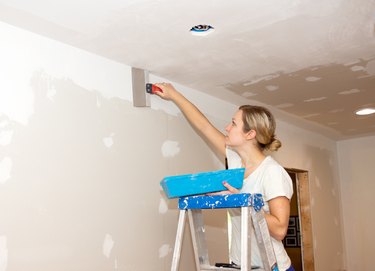
When you see a separation in a drywall ceiling, it's because the tape is either falling off or has torn, and there are four possible reasons. The first is simply that the person who did the taping didn't use enough mud, and if that's the problem, it's relatively easy to fix. The other three reasons are that the ceiling is wet, the foundation of the house is shifting, or the roof is lifting, and they require extra research and structural repairs.
When it comes to the actual cosmetic repair of retaping, you can do the job with paper tape and all-purpose mud. If you suspect, however, an underlying problem which you don't have the resources to address right now, fiberglass mesh tape and mud that sets chemically instead of just drying (drywall pros call this stuff hot mud) will make a longer-lasting repair. Hot mud is a little more difficult to use than regular mud, so if you want a perfect repair, you might be better off calling a pro.
Video of the Day
Video of the Day
Diagnosing the Reason for Seam Separation
Before you repair a seam separation in the ceiling, you need to determine why it's separating. If the problem is moisture — perhaps there's a roof or plumbing leak or the humidity in the room is too high — look for more signs of moisture damage on the ceiling. This would include bubbling paint; more than one seam separating; or dark, moldy splotches on the ceiling. If you see any of these, get on a ladder and check for sponginess along the seam itself.
Moisture is a big enough problem, but if the foundation of the house is shifting or the roof is lifting, the problem is even bigger. If foundation shifting is the problem, you'll see signs of it in other parts of the room. Look for cracks along seams above doors and windows as well as in the ceiling. If the shifting has been happening for a while, you may notice doors and windows sticking, doors swinging open when you leave them ajar, and possibly even slopes in the floor. Roof uplift is usually indicated by cracks in the corners between the ceiling and the walls.
Retaping a Poorly Taped Joint
When tape is separating because of moisture, you have to address the cause of the moisture or joint separation, or worse problems will occur. If you see no indications of moisture or structural problems, the probable cause for the tape separation is poor workmanship. To remedy this, you need to pull off the lifting tape and retape the joint. This will be a messy procedure, so be sure to cover the floor and all your furniture with drop cloths and wear goggles and a respirator.
Work a piece of tape loose with a putty knife, pull, and the tape and all the mud covering it will come crumbling off. After the tape is gone, clean all the rest of the crumbles off the joint with your putty knife. Be thorough because any you leave will interfere with the new mud. Spread the new all-purpose joint compound with a 4-inch drywall knife, embed paper drywall tape, scrape it flat, let it dry, and then apply two or three more coats of mud and scrape them flat until the joint is smooth. Sand the joint flat and finish by duplicating the ceiling texture on the area you repaired. Then prime and paint.
Retaping With Hot Mud
If you suspect the foundation of your house to be shifting or the roof to be lifting, there's a good chance the seam will separate again no matter how well you make the repair. However, fiberglass mesh tape and hot mud are stronger than conventional tape and mud and may hold for several years. The retaping procedure is essentially the same: Pull off the old tape, clean up, and retape.
Fiberglass tape is self-adhering and in some ways easier to work with than paper tape, but hot mud can be problematic. It comes as a powder, and after mixing it with water, you have a limited time to work with it before it sets. Once hard, most types are more difficult to sand. That's why you may prefer to entrust this job to a pro who has experience working with this material.